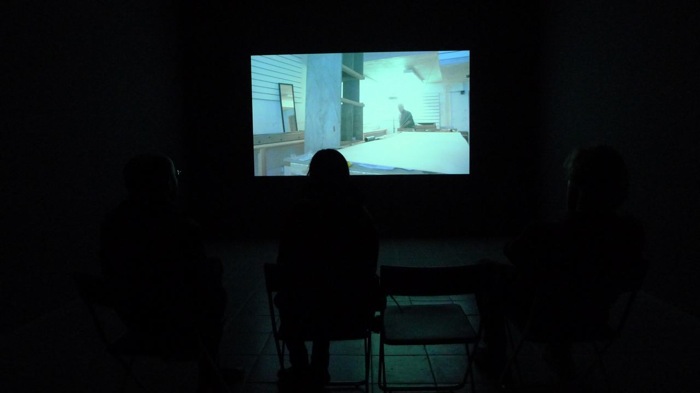

Tuesday 24 April: Stuart Brisley in conversation with Charles Esche
Art Monthly review by John Douglas Millar
April 2012 (Please go to Text section)
Review by Paul Hobson, Contemporary Art Society
April 2012
PEER
99 Hoxton Street, London N1 6QL
www.peeruk.org
Direction and Sound: Stuart Brisley
Camera: Chris Dorley-Brown
Editor: Stephen Connolly
Forthcoming event:
Tuesday 24 April at 6.30pm
Stuart Brisley in conversation with Charles Esche.
Stuart Brisley took up temporary residence in the abandoned shop next to PEER over a ten-day period in May 2010. This exhibition comprises a major new film work and a series of photographic stills taken at that time.
Working with the accumulated detritus and various shop fittings left by the three previous tennants – a bookseller, a sign-maker and a dealer in white goods – Brisley constructed, dismantled, arranged, activated, ordered and ultimately disordered this random and varied collection of stuff. Brisley’s environment and the actions that he brought to bear within the space were in a constant flux of becoming and unbecoming; this was a world in microcosm. Over the ten days things were piled up and pulled apart to form an ever-changing heap, an evolving structure that was both mountainous and monstrous in equal measure. References to Caspar David Friedrich, Delacroix and Gericault appeared on texts in the gallery, as did references to the economy, democracy and the monarch. Also in the gallery space Brisley’s portrait of Prince Charles (Seeing Red, 1995) was hung – in the space next door his portrait of the Queen (Monarch at Bay, 1995) leant informally against the wall as a symbol whose power is in question.
From the hours of footage shot inside the space over those ten days, a 30-minute film has been made. The camera’s eye-view scrutinises the terrain as well as the action through a series of both fixed and carefully paced uninterrupted panning shots from a number of positions within the space. Action, environment and objects are treated equally as subject matter. This dispassionate, surveillance-like camerawork gives the film a mesmeric intensity. Time is condensed and distilled through an edit that gives to the film an immersive impact. A carefully constructed sound-scape has been created from the original audio soundtrack where bashing objects, screeching metal and the ambient or accidental noise of Brisley negotiating the terrain is subtly manipulated to intensify the film’s brooding sense of ill ease and menace. This film is screened in the space where this activity took place, which has now been incorporated into PEER’s gallery space, adding a sense of both rootedness and dislocation to the work.
The still photographs tell a different version of the same story. In contrast to the film, the camera’s viewing position is that of the audience – from outside on the street observing through the dirty plate glass window covered in manufacturers' logos, and also from the gallery through a viewing slot in the wall between the two spaces. Employing the reflective properties of the glass through which these images are taken, glimpses of outside are often superimposed onto the image in such a way that questions the extent to which Brisley’s action has a connection to or separation from the world beyond the shop’s walls and windows. Trees, sunlight, blue skies and passers by are all captured in the transparent membrane of the shop window. This overlaying of images of the outside onto the inside inflects these photographs with a humanity and warmth so that the sense of the abject present in the film has, in the photographs, taken on a sense of empathy and pathos.